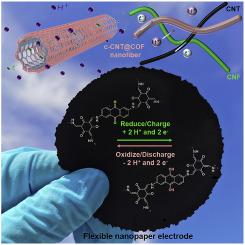Our official English website, www.x-mol.net, welcomes your
feedback! (Note: you will need to create a separate account there.)
Redox Active Covalent Organic Framework-Based Conductive Nanofibers for Flexible Energy Storage Device
Carbon ( IF 10.5 ) Pub Date : 2021-01-01 , DOI: 10.1016/j.carbon.2020.09.003 Xueying Kong , Shengyang Zhou , Maria Strømme , Chao Xu
Carbon ( IF 10.5 ) Pub Date : 2021-01-01 , DOI: 10.1016/j.carbon.2020.09.003 Xueying Kong , Shengyang Zhou , Maria Strømme , Chao Xu

|
Abstract Covalent organic frameworks (COFs) constitute a family of crystalline porous polymers that are being studied for electrochemical energy storage. However, their low electrical conductivity and poor processability have largely limited their electrochemical performances and practical applications. Here, we develop an interfacial synthesis method to grow few-layered 2D redox-active COFs (DAAQ-TFP COF) on the surface of carboxylated carbon nanotubes (c-CNTs) in order to fabricate core-shell c-CNT@COF nanofibers, for which the thickness and the morphology of the COF nanolayers can be finely controlled. When using the c-CNT@COFs as electrode material, the tailored nanostructure with high electrical conductivity allows efficient electron transfer, while the few-layered structure of the COF promotes fast electrolyte ion diffusion in the near-surface region, which results in an efficient utilization of the redox active sites in COF. More significantly, c-CNT@COFs with nanofibrous structure show good processability and can be assembled into freestanding and flexible nanopapers with the assistance of Cladophora cellulose. Given the good electrochemical performance and excellent flexibility, the nanopaper electrodes are assembled into flexible hybrid capacitors, showing high areal capacitance and extremely long lifetime. This study provides a new pathway for the development of next generation sustainable and flexible energy storage devices based on COFs and cellulose materials.
中文翻译:

用于柔性储能装置的基于氧化还原活性共价有机框架的导电纳米纤维
摘要 共价有机骨架 (COF) 构成了一系列用于电化学储能的结晶多孔聚合物。然而,它们的低导电性和加工性差在很大程度上限制了它们的电化学性能和实际应用。在这里,我们开发了一种界面合成方法,在羧化碳纳米管 (c-CNT) 的表面上生长少层的 2D 氧化还原活性 COF(DAAQ-TFP COF),以制造核-壳 c-CNT@COF 纳米纤维,为此,可以精细控制 COF 纳米层的厚度和形态。当使用 c-CNT@COFs 作为电极材料时,具有高导电性的定制纳米结构允许有效的电子转移,而 COF 的少层结构促进了近表面区域中电解质离子的快速扩散,从而有效利用了 COF 中的氧化还原活性位点。更重要的是,具有纳米纤维结构的 c-CNT@COFs 具有良好的可加工性,并且可以在 Cladophora 纤维素的帮助下组装成独立且灵活的纳米纸。鉴于良好的电化学性能和优异的柔韧性,纳米纸电极组装成柔性混合电容器,显示出高面电容和极长的寿命。该研究为开发基于COFs和纤维素材料的下一代可持续和灵活的储能装置提供了新的途径。具有纳米纤维结构的 c-CNT@COFs 具有良好的可加工性,可以在 Cladophora 纤维素的帮助下组装成独立且灵活的纳米纸。鉴于良好的电化学性能和优异的柔韧性,纳米纸电极组装成柔性混合电容器,显示出高面电容和极长的寿命。该研究为开发基于COFs和纤维素材料的下一代可持续和灵活的储能装置提供了新的途径。具有纳米纤维结构的 c-CNT@COFs 具有良好的可加工性,可以在 Cladophora 纤维素的帮助下组装成独立且灵活的纳米纸。鉴于良好的电化学性能和优异的柔韧性,纳米纸电极组装成柔性混合电容器,表现出高面电容和极长的寿命。该研究为开发基于COFs和纤维素材料的下一代可持续和灵活的储能装置提供了新的途径。显示出高面积电容和极长的寿命。该研究为开发基于COFs和纤维素材料的下一代可持续和灵活的储能装置提供了新的途径。显示出高面积电容和极长的寿命。该研究为开发基于COFs和纤维素材料的下一代可持续和灵活的储能装置提供了新的途径。
更新日期:2021-01-01
中文翻译:

用于柔性储能装置的基于氧化还原活性共价有机框架的导电纳米纤维
摘要 共价有机骨架 (COF) 构成了一系列用于电化学储能的结晶多孔聚合物。然而,它们的低导电性和加工性差在很大程度上限制了它们的电化学性能和实际应用。在这里,我们开发了一种界面合成方法,在羧化碳纳米管 (c-CNT) 的表面上生长少层的 2D 氧化还原活性 COF(DAAQ-TFP COF),以制造核-壳 c-CNT@COF 纳米纤维,为此,可以精细控制 COF 纳米层的厚度和形态。当使用 c-CNT@COFs 作为电极材料时,具有高导电性的定制纳米结构允许有效的电子转移,而 COF 的少层结构促进了近表面区域中电解质离子的快速扩散,从而有效利用了 COF 中的氧化还原活性位点。更重要的是,具有纳米纤维结构的 c-CNT@COFs 具有良好的可加工性,并且可以在 Cladophora 纤维素的帮助下组装成独立且灵活的纳米纸。鉴于良好的电化学性能和优异的柔韧性,纳米纸电极组装成柔性混合电容器,显示出高面电容和极长的寿命。该研究为开发基于COFs和纤维素材料的下一代可持续和灵活的储能装置提供了新的途径。具有纳米纤维结构的 c-CNT@COFs 具有良好的可加工性,可以在 Cladophora 纤维素的帮助下组装成独立且灵活的纳米纸。鉴于良好的电化学性能和优异的柔韧性,纳米纸电极组装成柔性混合电容器,显示出高面电容和极长的寿命。该研究为开发基于COFs和纤维素材料的下一代可持续和灵活的储能装置提供了新的途径。具有纳米纤维结构的 c-CNT@COFs 具有良好的可加工性,可以在 Cladophora 纤维素的帮助下组装成独立且灵活的纳米纸。鉴于良好的电化学性能和优异的柔韧性,纳米纸电极组装成柔性混合电容器,表现出高面电容和极长的寿命。该研究为开发基于COFs和纤维素材料的下一代可持续和灵活的储能装置提供了新的途径。显示出高面积电容和极长的寿命。该研究为开发基于COFs和纤维素材料的下一代可持续和灵活的储能装置提供了新的途径。显示出高面积电容和极长的寿命。该研究为开发基于COFs和纤维素材料的下一代可持续和灵活的储能装置提供了新的途径。











































 京公网安备 11010802027423号
京公网安备 11010802027423号